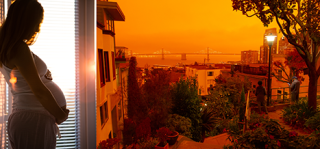Wildfire Smoke and Pregnancy
Explore Other Kids and Climate Health Impacts
Find information on how climate change can affect wildfire frequency and maternal child health. Start by reading the fictional story of a pregnant woman who is affected by wildfire smoke and learn how similar situations can affect pregnant women across the country. Also get tools to help families prepare and cope with outcomes from climate-related activity. Finally, check out the regional spotlight.
Caroline's Story
A young woman named Caroline is nervous about risks to her pregnancy from wildfires occurring in her area. Caroline is in her third trimester and has heard that exposure to wildfire smoke can increase the risk of preterm birth and low birthweight. She has been speaking to her doctor about how to protect herself and her baby.

Climate Change Impacts
- Over the last few decades, wildfire activity has increased significantly, especially in the western United States. This increase is associated with a variety of factors including climate change.1
- In the western United States, these fires have also become larger, hotter, more destructive, and more deadly.1
Impacts on Pregnancy
- A study found that pregnant women who were exposed to particulate matter (PM2.5) from wildfire smoke faced a higher risk of preterm birth than women who were not exposed.2,3
What can I do?
- DO evacuate from the path of wildfires and stay up to date on current evacuation orders.
- DO avoid smoke exposure when possible. If you must go outside, wear a NIOSH-approved, tightly fitting respirator. Learn more about respirators and masks. (pdf)
- DO check local air quality reports and follow instructions for “sensitive individuals.” View your local Air Quality Index. Continue to check local air quality reports and do not return home until you are told it is safe to do so. View the AirNow Fire and Smoke map.
- DO learn how to keep smoke out of your home. Some home heating, ventilation, and air conditioning (HVAC) systems and appliances can bring in outside air. Close the fresh-air intake on air conditioning units or turn the system to recirculate mode. Seal gaps between window air conditioners or portable air conditioners and the window. Use evaporative (swamp) coolers sparingly during smoky conditions because these devices must bring in a lot of outdoor air to cool the indoor air.
- DO keep the air indoors as clean as possible:
- Consider using a high-efficiency filter in your central HVAC system. Select one with a MERV 13 rating, or as high a rating as your system fan and filter slot can accommodate. You may need to consult a professional HVAC technician to determine the highest efficiency filter that will work best for your system. Find out how to turn the fan to “On” (instead of “Auto”) so that you can run the system fan as often as possible during a smoke event.
- Consider purchasing a portable air cleaner to filter the air in your home. Choose one that is sized for the room in which you will use it. Make sure the portable air cleaner does not make ozone. The California Air Resources Board maintains a list of air cleaners that have been tested and shown to emit little or no ozone. Learn how to set the fan to run continuously at the highest speed during a smoke event.
- If a portable air cleaner is not available or affordable, learn how to build a DIY air cleaner. (pdf)
- Learn more about protecting indoor air quality during a wildfire.
- DO air out the house when the air quality improves, even temporarily.
- DO keep an emergency supply of bottled water (1 gallon per person).
- DO buy groceries that don’t need to be cooked.
- DO stock up on seven to 10 days' worth of prescription medicines and prenatal vitamins. Learn more about preparing for wildfires during pregnancy.
- DO create an emergency care plan with your healthcare provider. Learn more about wildfire smoke and health during pregnancy.
What should I not do?
- DON'T open windows. Use fans and air conditioning to stay cool. If you cannot stay cool, seek shelter elsewhere.
- DON'T do anything that may worsen air quality indoors, including cooking or burning candles. Using unvented combustion appliances (such as barbecues, hibachis, camp stoves, or gas heaters) indoors for cooking and heating can lead to carbon monoxide poisoning.
The northern Great Plains includes Montana, Nebraska, North Dakota, South Dakota, and Wyoming.
- From the 1970s to the 2000s, the number of wildfires in the northern Plains has increased by almost 890%, and the length of the fire season has increased by 85 days due to a variety of climate impacts. Climate change is expected to lead to larger and more severe wildfires in the region.4
More Resources
- Air Now: Air Quality Monitoring
- Air Now: Wildfire Smoke Factsheet (pdf)
- Fire Now: Fire and Smoke Map
- EPA: Wildfires and Indoor Air Quality
- EPA: Create a Clean Room to Protect Indoor Air Quality During a Wildfire
- EPA: Wildfires and Indoor Air Quality in Schools and Commercial Buildings
- Wildfire Smoke Factsheet: Prepare for Fire Season
- EPA Why is Coco Red? (pdf)
- EPA Smoke Ready Toolbox for Wildfires
- EPA Wildfires
- CDC Wildfires
- CDC Ready Wrigley Prepares for Wildfires & Smoke
- Ready.gov Wildfires
- Ready.gov Prepare with Pedro! Wildfire (pdf)
- Children's Environmental Health Collaborative: State of Global Air 2024
- Children's Environmental Health Collaborative: Safe from Wildfire Smoke
- Children’s Environmental Health Collaborative: Wildfire Safety Tips
- PEHSUs: A Story of Health
